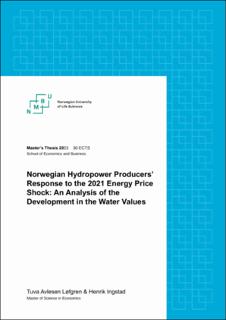| dc.description.abstract | Norwegian electricity prices surged during the last half of 2021. A significant increase in the European gas prices and the prices of carbon allowances, low inflow to the reservoirs in southern Norway, and increased demand due to the post-pandemic rebound of economic activity were central drivers for the increase in the electricity price. Soaring prices in thermal energy sources and diminishing water levels in the reservoir have shown how volatile the electricity price can be in a power system that predominantly relies on hydropower. Consequently, understanding how these price determinants influenced the water values of the Norwegian hydropower producers in 2021, will be an important factor to ensure the energy security in the future.
This paper analyses the development of the water values of 17 Norwegian hydropower plants in price areas NO2 and NO5 in the last half of 2021. Through a double censored regression model, the study finds that 71,4 % of the hydropower plants with reliable results had an increasing trend in the water values, while 21,4 % had a decreasing trend. Furthermore, the study analyses how the hydropower producers reacted to the development in the Norwegian and European energy markets. The study finds that 78,6 % of the hydropower producers increased the water values when the gas price increased, and 71,4 % reduced their water values when the European gas storage levels increased. If the carbon spot price increased, 27 % of the hydropower producers increase the water values, while 84,6 % of the producers lowered the water values when the reservoir filling increased.
By applying the rolling window approach to the double censored regression model, we identified potential responses to the market signals for six of the hydropower plants in the study. The responses suggested that the hydropower producers changed their expectations with respect to the market signal, and thus revised their models. The study found that five producers responded in late August and September, while one plant may have had a reaction in November. The evidence suggests that 100 % of the responses indicated a reaction to the European gas storage filling. It was found that 71 % of the responses were associated with the degree of reservoir filling of the hydropower plant. 43 % of the responses could indicate a reaction to the carbon spot price, and 71 % of the responses were associated with a change in expectations of the gas price. However, there was a great deal of uncertainty related to the results from the rolling window analysis, and the evidence should be viewed with caution. | |
